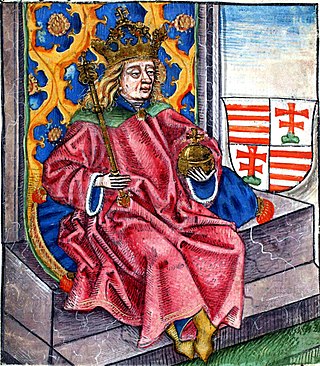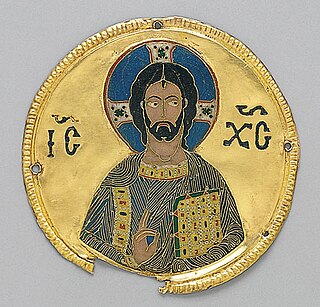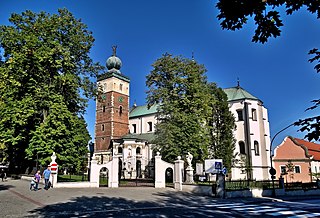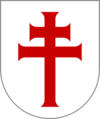
Andrew II, also known as Andrew of Jerusalem, was King of Hungary and Croatia between 1205 and 1235. He ruled the Principality of Halych from 1188 until 1189/1190, and again between 1208/1209 and 1210. He was the younger son of Béla III of Hungary, who entrusted him with the administration of the newly conquered Principality of Halych in 1188. Andrew's rule was unpopular, and the boyars expelled him. Béla III willed property and money to Andrew, obliging him to lead a crusade to the Holy Land. Instead, Andrew forced his elder brother, King Emeric of Hungary, to cede Croatia and Dalmatia as an appanage to him in 1197. The following year, Andrew occupied Hum.

Godfrey of Bouillon was a French nobleman and pre-eminent leader of the First Crusade. First ruler of the Kingdom of Jerusalem from 1099 to 1100, he avoided the title of king, preferring that of prince (princeps) and Advocatus Sancti Sepulchri, or Advocate of the Holy Sepulchre. Second son of Eustace II, Count of Boulogne, Godfrey became Lord of Bouillon in 1076 and in 1087 Emperor Henry IV confirmed him as Duke of Lower Lorraine, a reward for his support during the Great Saxon Revolt.

The Latin Patriarchate of Jerusalem is the Latin Catholic ecclesiastical patriarchate in Jerusalem, officially seated in the Church of the Holy Sepulchre. It was originally established in 1099, with the Kingdom of Jerusalem encompassing the territories in the Holy Land newly conquered by the First Crusade. From 1374 to 1847 it was a titular see, with the patriarchs of Jerusalem being based at the Basilica di San Lorenzo fuori le Mura in Rome. A resident Latin patriarch was re-established in 1847 by Pius IX.

Béla IV was King of Hungary and Croatia between 1235 and 1270, and Duke of Styria from 1254 to 1258. As the oldest son of King Andrew II, he was crowned upon the initiative of a group of influential noblemen in his father's lifetime in 1214. His father, who strongly opposed Béla's coronation, refused to give him a province to rule until 1220. In this year, Béla was appointed Duke of Slavonia, also with jurisdiction in Croatia and Dalmatia. Around the same time, Béla married Maria, a daughter of Theodore I Laskaris, Emperor of Nicaea. From 1226, he governed Transylvania as duke. He supported Christian missions among the pagan Cumans who dwelled in the plains to the east of his province. Some Cuman chieftains acknowledged his suzerainty and he adopted the title of King of Cumania in 1233. King Andrew died on 21 September 1235 and Béla succeeded him. He attempted to restore royal authority, which had diminished under his father. For this purpose, he revised his predecessors' land grants and reclaimed former royal estates, causing discontent among the noblemen and the prelates.

The Equestrian Order of the Holy Sepulchre of Jerusalem, also called Order of the Holy Sepulchre or Knights of the Holy Sepulchre, is a Catholic order of knighthood under the protection of the Holy See. The pope is the sovereign of the order.

The King of Jerusalem was the supreme ruler of the Kingdom of Jerusalem, a Crusader state founded in Jerusalem by the Latin Catholic leaders of the First Crusade, when the city was conquered in 1099.
The Church of the Holy Sepulchre is a church in the Christian Quarter of the Old City of Jerusalem, believed to be the site of Jesus's empty tomb.

Emeric, also known as Henry or Imre, was King of Hungary and Croatia between 1196 and 1204. In 1184, his father, Béla III of Hungary, ordered that he be crowned king, and appointed him as ruler of Croatia and Dalmatia around 1195. Emeric ascended the throne after the death of his father. During the first four years of his reign, he fought his rebellious brother, Andrew, who forced Emeric to make him ruler of Croatia and Dalmatia as appanage.

Canons regular are priests who live in community under a rule and are generally organised into religious orders, differing from both secular canons and other forms of religious life, such as clerics regular, designated by a partly similar terminology.
Joscius was Archbishop of Tyre in the crusader Kingdom of Jerusalem in the late 12th century.
The Crosiers or Brethren of the Cross or crutched friars is a general name for several loosely related Catholic orders, mostly canons regular. Their names derive from their devotion to the Holy Cross. They were founded in the 12th and 13th centuries, during the era of the crusades in the Holy Land. These orders tended to maintain hospitals and care for the sick. Currently, the term "crosiers" most frequently refers to the Canons Regular of the Order of the Holy Cross originating from Belgium, but it could also refer to at least five other orders from Jerusalem, Portugal, Italy, Bohemia, Poland–Lithuania, and a group of friars in England and Ireland.

Jerusalem's role in first-century Christianity, during the ministry of Jesus and the Apostolic Age, as recorded in the New Testament, gives it great importance. Jerusalem is generally considered the cradle of Christianity.

The Canonesses Regular of the Holy Sepulchre (CRSS), or Sepulchrine Canonesses, are a Catholic female religious order first documented in 1300. They were originally the female branch of the ancient religious order of that name, the Canons Regular of the Holy Sepulchre. The canonesses follow the Rule of St. Augustine.

The Custody of the Holy Land is a custodian priory of the Order of Friars Minor in Jerusalem, founded as the Province of the Holy Land in 1217 by Saint Francis of Assisi, who had also founded the Franciscan Order in 1209. In 1342, the Franciscans were declared by two papal bulls as the official custodians of the Holy Places in the name of the Catholic Church.

Christianity in the 11th century is marked primarily by the Great Schism of the Church, which formally divided the State church of the Roman Empire into Eastern (Greek) and Western (Latin) branches.

The Church of the Holy Sepulchre in Miechów, Poland, is a 14th-century Gothic basilica, with a nave and two aisles, incorporating some 13th-century Romanesque stonework. It received many privileges from Casimir of Bytom.

The orders, decorations, and medals of the Holy See include titles, chivalric orders, distinctions and medals honoured by the Holy See, with the Pope as the fount of honour, for deeds and merits of their recipients to the benefit of the Holy See, the Catholic Church, or their respective communities, societies, nations and the world at large.

John was a prelate in the Kingdom of Hungary in the 12th and 13th centuries. He was Bishop of Csanád between 1198 and 1201, Archbishop of Kalocsa from 1202 to 1205 and Archbishop of Esztergom between 1205 and 1223. He crowned Ladislaus III of Hungary, Andrew II of Hungary and Coloman of Halych king. Andrew II appointed him to govern the kingdom during his crusade between 1217 and 1218.
Robert of Nantes was the Latin patriarch of Jerusalem from 1240 to 1254.
The title of Advocatus Sancti Sepulchri, or Advocate of the Holy Sepulchre, has been ascribed to Godfrey of Bouillon in his role as the first Latin ruler of Jerusalem. In the aftermath of the First Crusade, there was disagreement among the clergy and secular leaders as the leadership of the Kingdom of Jerusalem. There was opposition to the naming of a king over the Holy City and the wearing of a crown in the city where Christ suffered with a crown of thorns. The original sources differ on the actual title assumed by Godfrey. However, it is generally accepted by most modern historians that, once Godfrey was selected to be leader, he declined to be crowned king instead taking the titles of prince (princeps) and advocate or defender of the Holy Sepulchre.


















